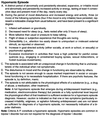NEUROPSYCH Flashcards
(128 cards)
Categories of Psychiatric Disorders
- Neurodevelopmental disorders
- Neurocognitive disorders
- Personality disorders
- Psychosis
- Depressive Disorders
- Bipolar Disorders
- Anxiety diorders
- Trauma or stressor related diorders
- Substance use disorders
- Somatic symptom and related disorders
Obsessive compulsive Disorders
Neurodevelopmental disorders
Inborn conditions of the CNS
Includes:
- ADHD
- ASD
- Intellectual Disability
- Specific Learning Disorders
ADHD
- Inattention
- Hyperactivity and/or
- impulsitivity
ASD
Social impairment and sterotypic behaviors
Intellectual Disability
impairments in adaptive functioning + documented subpar intellect, usually via IQ testing
Specific Learning Disorder
formerly called dyslexia
Neurocognitive Diorders
Conditions affecting the CNS that impacts a person’s cognitive capacity, which includes memory, language, attention, perception, and executive functons. formerly called dementia describes a long term cognitive decline
Delirium
Neurologic diagnosis of encephalopathy - a global disruption off brain function
Personality disorders
enduring pattern of inner experience and behavior that is inflexible, pervasive, causes distress or dysfunction, and is stable in late adolescence/early adulthood onwards.
Cluster A (odd and eccentric)
tendency towards psychosis; may represent prodrome or residual symptoms of schizophrenia
- Paranoid
- Schizoid
- Schizotypal
Paranoid
suspicious and distrubing
Schizoid
detached and lacking in emotion
Schizotypal
distorted and magical thinking
Cluster B (“emotional and erratic’)
tendency towards Mood disorders
- Histrionic
- Narcissistic
- Antisocial
- Borderline
Histrionic
attention seeking and emotional
Narcissistic
self important, lacking in empathy, needing admiration
Antisocial
disregard for laws and rights of others; with evidence of conduct disorder before 15 years of age
Borderline
unstable sense of self; tends to be impulsve; associated with self-harm, turbulent relationships, and emotional outbursts
Cluster C (“fearful and ansious”)
tendency towards anxiety disorders
- dependent
- avoidant
- obsessive
- compulsive
Dependent
clingy and submissive
Avoidant
socially inhibited with feelings of inadequacy
Obsessive compulsive
perfectionist and rigid
Anxiety Disorders
Can include 2 phenomenoms:
- fear, which is mediated by the amygdala and is connected to the sympathetic nervous system
- worrying, which is a cognitive processess mediated by the cortico-striatal pathway
Panic Disorders
presence of 1 panic attack + 1 month of more of persistent worrying or maladaptive change in behavior in response to the attack









